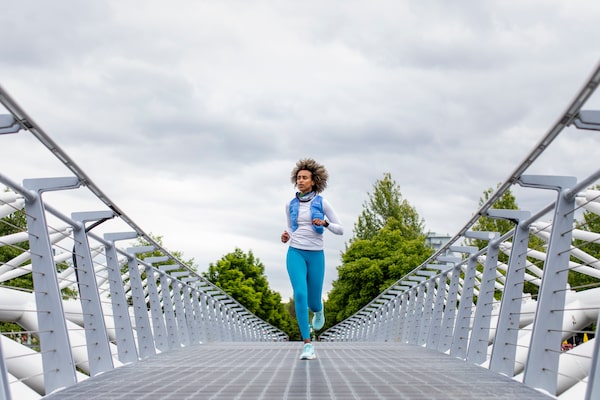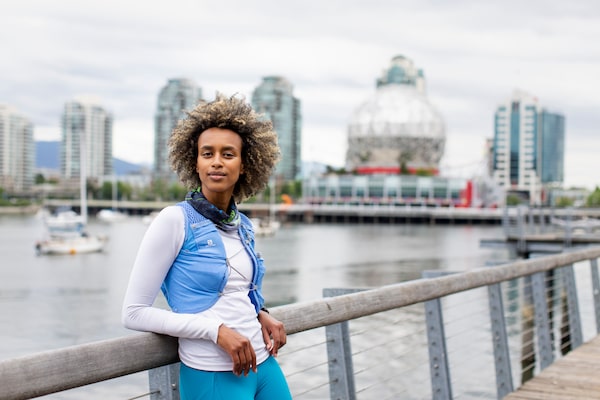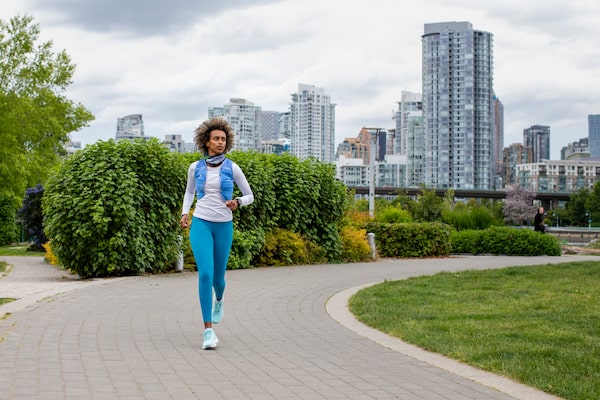
Filsan Abdiaman, creator of Project Love Run, runs along Vancouver’s False Creek Seawall on May 26, 2021.Alia Youssef/The Globe and Mail.
Adam Lam used to go to his neighbourhood gym in Toronto five to six times a week to weight train and run on a treadmill. When COVID-19 hit and the gym closed temporarily, Mr. Lam stopped doing any physical activity and he was feeling the effects.
“My sleep schedule was really off,” he recalls. “I had insomnia and I felt like I had less energy.” Mr. Lam soon joined an online accountability group called Sea Change, which meets online weekly with the goal of altering habits. He was inspired to take action by group members who were doing regular outdoor walks and running.
By December, 2020, he started running a few times a week, and when spring arrived, he amped up his schedule to six times a week. This new fitness routine resolved his insomnia, and he found himself looking forward to running, unlike his gym workouts. “Before, going to the gym was motivated by guilt,” Mr. Lam explains. “Running now feels more like a recreational activity.”
Mr. Lam is one of many Canadians who have started outdoor running since the start of the pandemic. With gyms closed and recreational sports cancelled, it’s a relatively cheap and easy physical activity to take up.

Ms. Abdiaman does some stretching.Alia Youssef/the globe and mail
“There has also been more time in people’s schedules if they no longer had to commute or they were working from home,” says Dr. Kimberley A. Dawson, a professor in sport and exercise psychology at Wilfrid Laurier University. She adds that sedentary pandemic lifestyles are prompting Canadians to get moving. “People wanted an escape from virtual work and running is the most efficient way to move your body.”
Dr. Dawson noticed an increase of joggers around her neighbourhood in Waterloo, Ont. Multi-generational running groups have stood out the most. “I have seen an awful lot of kids that couldn’t play soccer any more, couldn’t do hockey any more, who are now running out there with their parents who’ve always been runners,” she says.
Tracking performance is an effective way for runners to motivate themselves and connect with an online community. Fitness apps have seen a jump in downloads since the pandemic. In March, 2020, the Nike Run Club App saw one million members log their first run and a 42-per-cent increase in runs logged through the app. In addition, Nike says existing members logged 27-per-cent more runs between March and September, 2020.
Mr. Lam uses the app Strava, liking and following his friends’ fitness journeys. He also has an Apple Watch and uses the Apple Fitness app to track his daily activities. “It gives you these three rings that fill up as you spend more time exercising,” he explains. “When my fitness started to ramp up, I wanted to fill those rings each day. It feels more like gamification.”

Ms. Abdiaman's Project Love Run has chapters in five cities across Canada.Alia Youssef/the globe and mail
Another mode of motivation and community-building is running clubs. Project Love Run is a women’s running group that used to meet for monthly runs ending in brunch and conversations. Filsan Abdiaman is the founder of the club, which has chapters in five cities across Canada. Ms. Abdiaman heads up the Vancouver chapter.
After the pandemic hit, Ms. Abdiaman moved her run clubs to a virtual format. “We set a [monthly] theme and post questions to reflect on when the individuals go out on their solo runs,” she explains, with former discussion themes including fertility and building community. “Then we have a Zoom call around midday and have a conversation tied back to the theme.”
Ms. Abdiaman herself is an ultrarunner and would usually compete in three races a year, some up to 100 kilometres long. “I was so used to training for races,” she says. “I forgot about running just for running itself.”
Last year, with COVID-19 and the Black Lives Matter uprising, Ms. Abdiaman was feeling stressed. “Around that time, I would go running to be free from that stress and just clear my mind by tuning into my body.” Ms. Abdiaman is looking forward to participating in races and marathons once they return.
But now that some runners have developed their own routines and running habits outside of marathon training, Dr. Dawson believes they may no longer need the external motivation of an organized race. “The question will be, will they ever need to have any sort of competitive outcome to validate their running? I’m not sure that they will.”
With the return of post-pandemic life and demands such as after-school activities, office commutes and social affairs, Dr. Dawson anticipates that some runners will break their habits. “Once the barriers of time commitment come back into our world, I think it’s going to take away from the exercise component,” she says.
Mr. Lam intends to maintain his running routine but he may return to the gym in the winter. “Right now, I’m inclined to keep it up.”

Ms. Abdiaman is an ultrarunner and would usually compete in three races a year.Alia Youssef/the globe and mail
For pandemic-era runners that are keen to continue their habit. Ms. Abdiaman suggests removing the pressure of running a certain time or distance. “Just go out for a run and don’t worry about how far, how long you’ll be running for.
“Think of it as doing something good for your body. Try and pay attention to your surroundings and what your body’s telling you. Use those cues as a way to maybe run further, or as a way to learn something about who you are.”
 Andrea Yu
Andrea Yu